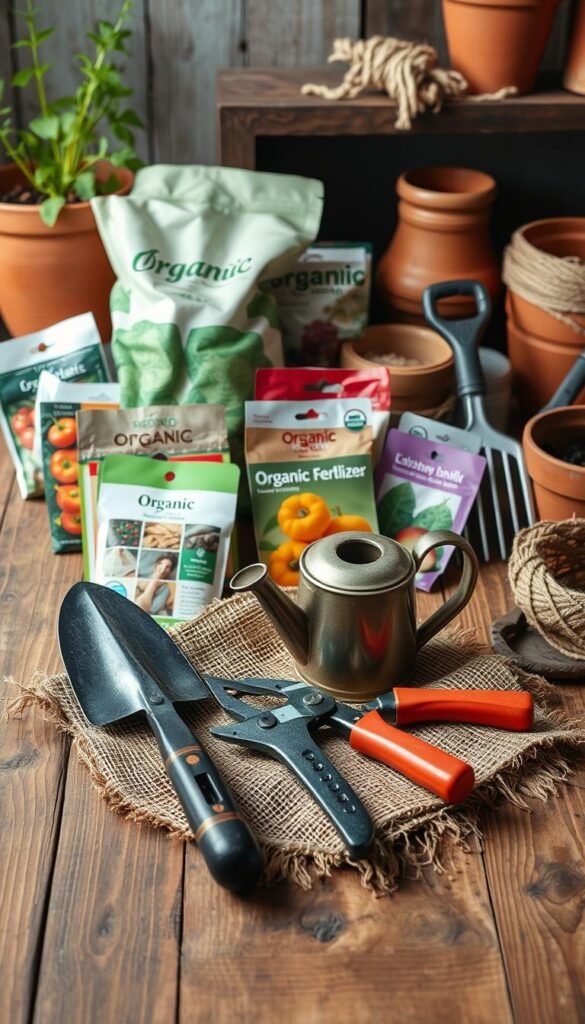Growing your own plants brings unique rewards, whether you’re nurturing herbs on a windowsill or cultivating vegetables in backyard beds. The secret to success lies in choosing tools and materials that work with nature rather than against it.
This guide focuses on practical solutions for various growing spaces – from compact containers to sprawling plots. You’ll discover how essential tools versus nice-to-have extras can simplify your routine while supporting sustainable practices.
We’ve prioritized earth-friendly options that reduce environmental impact without sacrificing functionality. Think durable hand tools made from recycled materials and natural pest control alternatives that keep chemicals out of your soil.
Whether you’re prepping raised beds or maintaining perennial flowers, proper preparation with quality supplies leads to healthier plants. You’ll save time troubleshooting issues and money replacing inferior products down the road.
Get ready to explore both time-tested essentials and clever innovations that make nurturing your green space more efficient and enjoyable. Let’s create growing conditions where every plant – and gardener – can flourish.
Welcome to Your Organic Gardening Journey
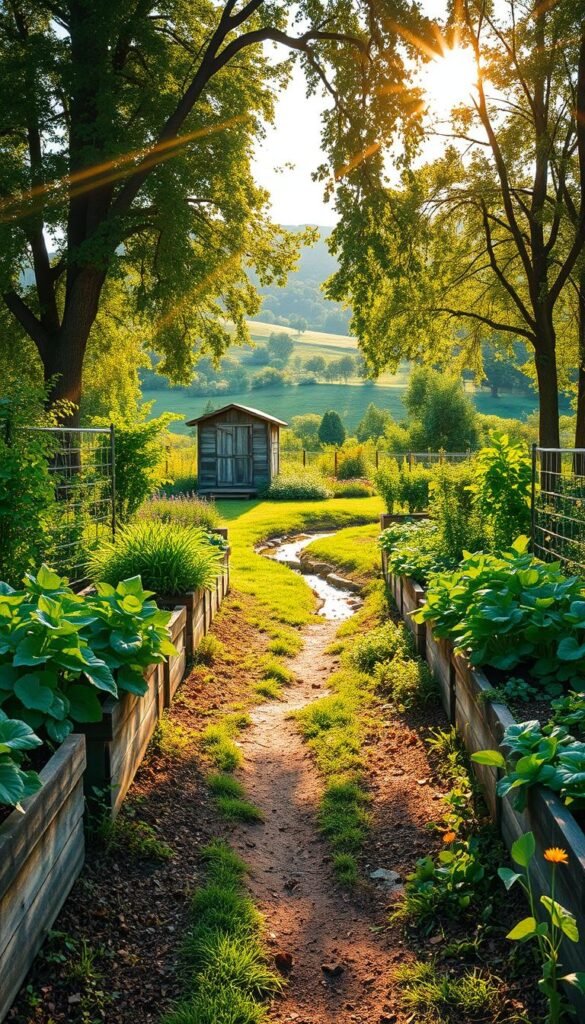
Starting your green space with earth-conscious techniques transforms how you grow food and connect with nature. Unlike conventional methods, organic approaches prioritize your family’s health and environmental balance through simple, natural solutions.
Embracing Organic Methods
Working with nature means avoiding synthetic chemicals that harm soil microbes and pollinators. Instead, you’ll rely on compost for nutrients and companion planting for pest control. These strategies create resilient plants that adapt to local conditions naturally.
Many beginners find organic gardening simplifies maintenance. Healthy soil retains moisture better, reducing watering needs. You’ll also spend less time battling pests when ladybugs and birds handle the job.
Why Eco-Friendly Practices Matter
Every chemical-free choice protects groundwater and supports biodiversity. A single chemical-free garden can host 35% more earthworms than treated plots, according to recent studies. These underground allies aerate soil and break down organic matter faster.
| Aspect | Organic Approach | Conventional Approach |
|---|---|---|
| Soil Health | Builds nutrients naturally over time | Depletes minerals, requires additives |
| Pest Control | Uses predator insects & plant partners | Relies on synthetic pesticides |
| Cost Over 3 Years | $120 (compost/seeds) | $290 (fertilizers/pesticides) |
This table shows how earth-friendly methods save money while producing better results. Your initial efforts create a self-sustaining system where plants thrive with minimal intervention.
By growing your own food this way, you control what touches your home-grown produce. Fresh tomatoes taste sweeter when ripened naturally, and leafy greens pack more nutrients without chemical residues.
Understanding Your Garden’s Unique Needs
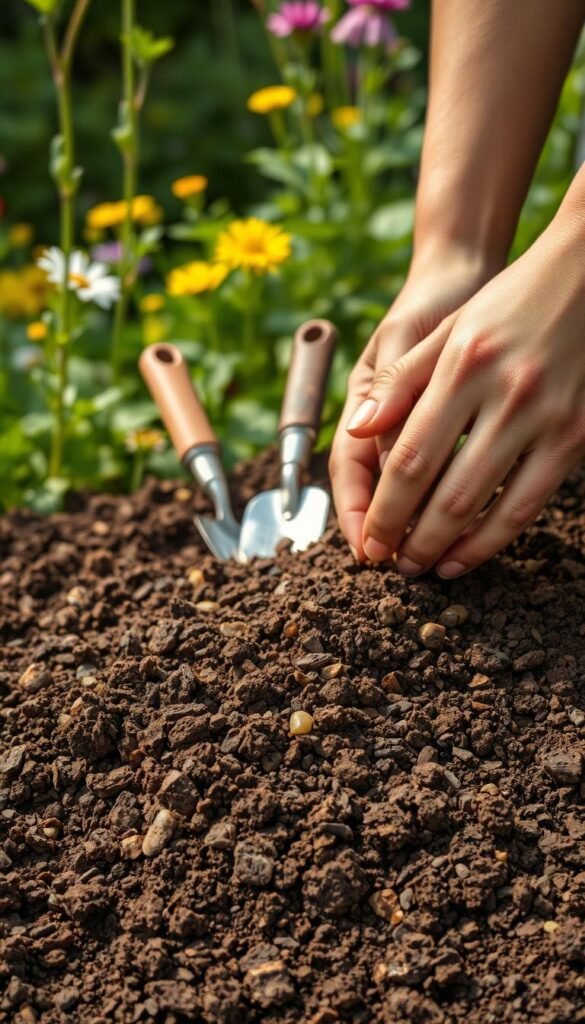
Every green space has its personality. What thrives in your neighbor’s yard might struggle in yours. The key lies in observing your environment and matching your tools to its specific character.
Groundwork Before Growth
Start with a simple soil test. Kits from local nurseries reveal pH levels and nutrient gaps. Acidic earth? Add crushed limestone. Sandy texture? Mix in compost. This knowledge saves time and money on unnecessary amendments.
Measure your available space like a designer. Balcony gardeners might choose stackable planters, while backyard growers could install vertical trellises. Compact tools like foldable rakes make small areas more manageable.
Watch for OMRI-certified labels when buying soil. True organic mixes list plant-based compost first, not poultry waste. As one grower notes: “My tomatoes doubled in size once I switched to verified blends.”
Rhythm of the Seasons
Your region’s frost dates dictate planting schedules. Coastal areas need wind-resistant stakes. Desert climates require drip irrigation kits. Track sunlight patterns – some plants crave six hours daily, others thrive in dappled shade.
Microclimates matter too. That south-facing wall? It’s a heat trap for peppers. The damp corner under gutters? Perfect for mint. Match your care routine to these hidden zones, and watch your garden flourish.
Building a Solid Foundation with Soil and Compost
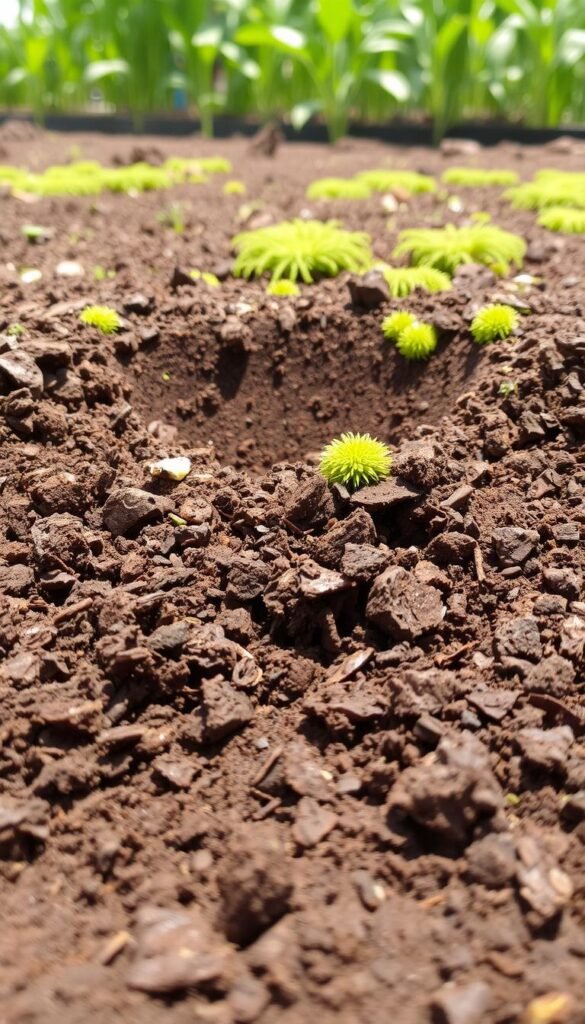
The secret to a flourishing garden lies beneath the surface, in the rich, living ecosystem of the soil. What you put into the earth directly impacts your plants’ resilience and your food quality. Let’s explore how to create this vital foundation.
Certified Organic Soil Options
Premium blends like Organic Mechanics prove you don’t need peat moss for success. Their formula mixes compost, pine bark, and perlite – creating airy, moisture-retentive earth perfect for roots. Always check labels: true organic soils list plant-based ingredients first and avoid synthetic additives.
“Switching to verified mixes changed my gardening game,” shares one urban grower. “My kale grew twice as large without extra fertilizers.” For best results, pair quality soil with targeted preparation techniques that enhance nutrient availability.
DIY Composting Techniques
The Combox system revolutionizes small-space composting. Its modular design lets you manage decomposition stages separately while growing flowers in unused sections. Toss in vegetable peels, coffee grounds, and leaves – nature handles the rest.
Well-made compost feeds plants for months, reducing kitchen waste by up to 30%. As your pile breaks down, it creates humus that improves soil structure naturally. This approach aligns perfectly with low-disturbance growing methods, preserving your garden’s delicate ecosystem.
Investing in these fundamentals pays dividends. Healthy earth means stronger produce, fewer pest issues, and gardens that improve yearly with minimal effort.
Top 10 Must-Haves in Your Organic Gardening Supplies Kit
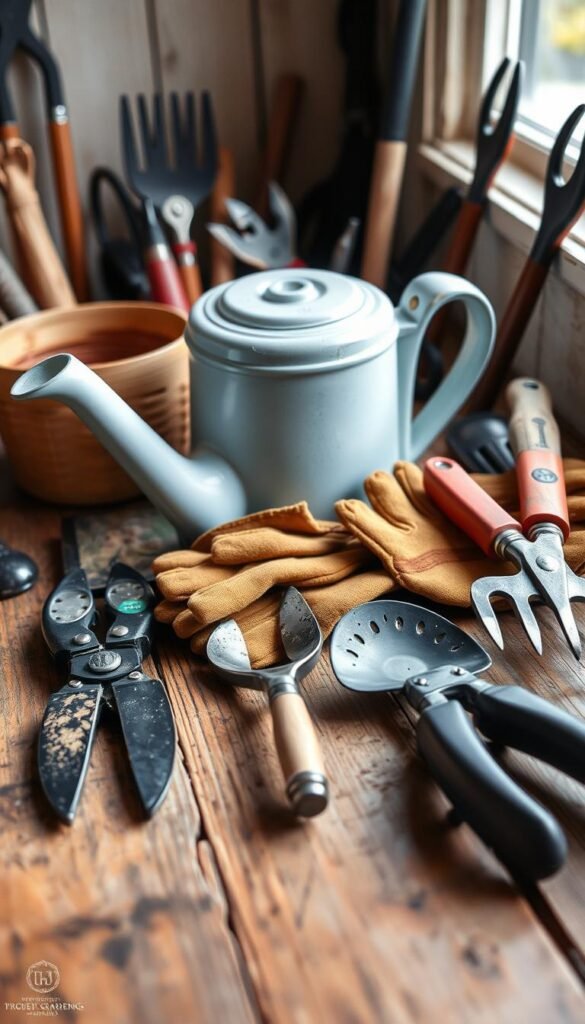
Smart gardeners know quality beats quantity when stocking their sheds. Instead of buying every shiny gadget, focus on versatile tools that handle multiple tasks. This approach keeps costs manageable while ensuring you’re ready for planting, weeding, and harvesting.
Essential Tools and Products Overview
Start with these workhorses that form 80% of daily gardening activities. A stainless steel trowel digs holes, transplants seedlings, and mixes soil amendments. Look for ergonomic handles – they reduce hand fatigue during long sessions.
| Priority | Item | Key Benefit |
|---|---|---|
| Essential | Hori-Hori Knife | Cuts roots, divides plants, measures depth |
| Essential | Collapsible Soil Sieve | Filters debris, stores flat |
| Year 2 Upgrade | Broadfork | Aerates soil without disrupting layers |
| Year 2 Upgrade | Compost Thermometer | Monitors decomposition speed |
Invest in products like OMRI-certified neem oil. It tackles pests and fungal issues without harming pollinators. Pair it with a brass pump sprayer for even application on leaves.
“My $40 pruners lasted eight seasons,” notes urban grower Lisa Chen. “Cheap versions broke mid-task.” Durable tools make tasks smoother and safer, especially when handling tough stems or rocky soil.
Beginners should prioritize these six essentials before expanding their collection. As your garden grows, add specialized items like seed starting kits or berry-picking baskets.
Seed Selection and Planting Techniques
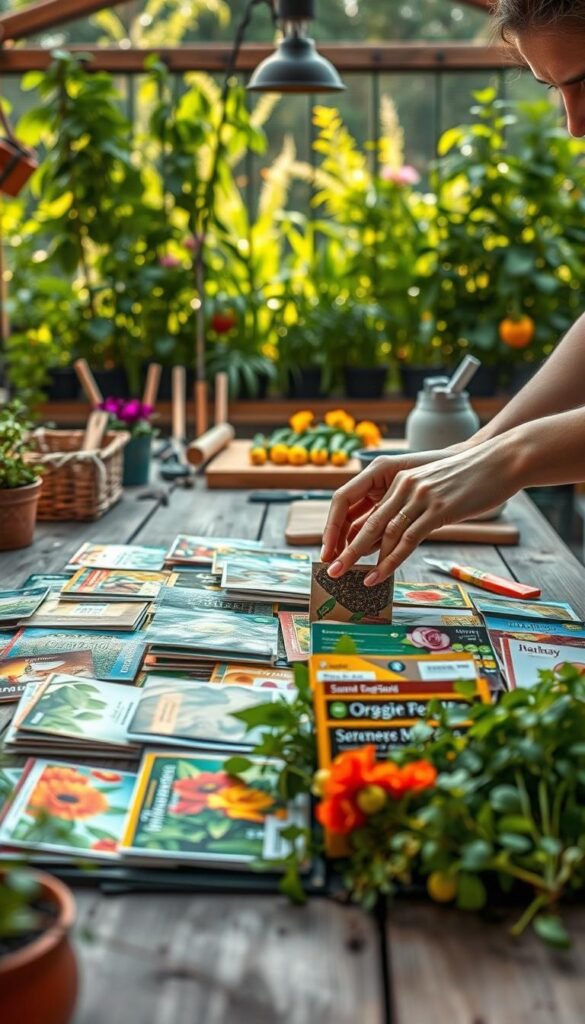
Your garden’s potential begins with what you put in the ground. Choosing the right seeds and methods determines whether your efforts yield vibrant blooms or robust vegetables. Let’s explore how to make smart choices from packet to plot.
Choosing Heirloom vs. Hybrid Seeds
Heirloom varieties like Brandywine tomatoes or Dragon Tongue beans offer flavors you won’t find in supermarkets. These seeds pass down traits through generations, preserving genetic diversity. Unlike hybrids, you can save their seeds for next year’s planting.
| Feature | Heirloom Seeds | Hybrid Seeds |
|---|---|---|
| Taste | Superior flavor profiles | Consistent but milder |
| Seed Saving | Produces true-to-type plants | Unpredictable results |
| Yield | Variable based on conditions | Higher in ideal settings |
| Best For | Flavor-focused gardeners | Commercial growers |
Trusted suppliers like Seed Savers Exchange and Victory Seeds offer 100+ year-old varieties. Their catalogs read like edible history books, featuring plants your great-grandparents might have grown.
Effective Planting Methods
Timing matters most. Start tomatoes 6-8 weeks before your last frost date. Bury seeds at twice their diameter – tiny lettuce seeds need shallow coverage, while peas thrive deeper. “I mark my calendar with moon phases for root vs. leaf crops,” shares urban gardener Lisa Chen.
Kabloom Seedboms simplify guerilla gardening. These clay-wrapped wildflower mixes thrive in neglected spaces. Just toss and let rain do the work – perfect for establishing pollinator habitats quickly.
Match varieties to your climate. Short-season areas need quick-maturing vegetables like Arctic Beauty tomatoes. Southern growers should seek heat-tolerant okra or Malabar spinach. Proper selection ensures your plant growth aligns with nature’s schedule.
Eco-Friendly Mulching and Natural Fertilizers
Your garden’s defense system grows from the ground up. A 2-3 inch layer of mulch acts like nature’s thermostat, keeping soil temperatures stable while locking in moisture. This simple practice cuts watering frequency by 40% and creates a hostile environment for unwanted weeds.
Organic Mulch Varieties
Free materials often work best. Fallen leaves from deciduous trees create nutrient-rich leaf mold over winter. Grass clippings (from chemical-free lawns) add nitrogen but should be applied thinly to prevent matting. For acidic-loving plants like blueberries, pine needles offer perfect pH balance.
| Material | Best For | Decomposition Rate |
|---|---|---|
| Wood Chips | Perennial beds | Slow (1-2 years) |
| Grass Clippings | Vegetable gardens | Fast (2-4 weeks) |
| Pine Needles | Acidic soil plants | Moderate (6 months) |
| Leaves | General use | Moderate (3-6 months) |
| Straw | Winter protection | Slow (8-12 months) |
Benefits of Natural Fertilizers
Products like We The Wild’s Plant Food & Tonic Kit feed plants while building soil biology. Their microbial blends convert organic matter into usable nutrients, creating a self-sustaining cycle. Unlike synthetic options, these formulas won’t burn roots or contaminate groundwater.
Combine mulch with natural fertilizers to prevent common missteps like overwatering or nutrient depletion. Over time, this duo transforms your garden into a low-maintenance ecosystem where weeds struggle and desired plants thrive.
Tools That Empower Your Gardening Efforts
The right equipment transforms gardening from chore to joy. Quality implements reduce strain while boosting efficiency, letting you focus on nurturing plants rather than fighting inadequate gear.
Hand Tools for Precision and Care
Ergonomic design makes all the difference. The Radius NRG trowel features an angled handle that aligns with natural wrist motion, preventing soreness during hours of digging. Its aluminum blade slices through roots while maintaining feather-light weight.
When choosing gloves, prioritize breathable fabrics with reinforced fingertips. Look for:
- Water-resistant palms for muddy tasks
- Extended cuffs protecting wrists
- Non-slip grips on wet surfaces
“My stainless steel hand trowel outlasted three plastic versions,” shares community gardener Marissa Torres. Durable steel tools resist rust and bend less under pressure.
Innovative and Durable Equipment
Modern designs solve age-old problems. Telescoping weeders reach deep roots without kneeling. Foldable tool sets save space in small sheds. Consider these material advantages:
| Material | Benefit | Best For |
|---|---|---|
| Stainless Steel | Rust-proof | Wet climates |
| Forged Aluminum | Lightweight | Container gardens |
| Rubber-Coated | Shock absorption | Rocky soil |
Well-balanced hand tools minimize fatigue – crucial for seniors or those with arthritis. The right gear makes every planting session feel effortless, letting you work smarter in your green space.
Watering, Irrigation, and Sustainable Hydration
Proper hydration keeps your garden thriving without wasting resources. Smart solutions balance plant needs with environmental care, whether you’re tending balcony herbs or sprawling vegetable beds.
Rain Barrels and Efficient Garden Hoses
The Smartware Rain Barrel turns stormwater into a watering asset. Its 98% recycled plastic construction features a stainless steel spigot and mesh screen, filtering debris while storing 55 gallons. Position barrels under downspouts to capture free water for thirsty plants.
When selecting a garden hose, measure your space first. A 25-foot hose maintains better pressure than 100-foot versions for small yards. Look for kink-resistant models with brass fittings – they last 3x longer than plastic connectors.
Modern Irrigation Systems for Low Maintenance
Upgrade to drip irrigation kits for precise moisture delivery. These systems cut watering time by 50% while directing hydration straight to roots. Pair them with timers for vacation-proof care.
Indoor growers love the Haws Watering Can’s balanced handle and slender spout. Its controlled flow prevents soil disruption in seed trays. Outdoor enthusiasts might add soaker hoses – they’re budget-friendly alternatives that mimic natural rainfall patterns.
Every choice impacts your garden’s health and your time investment. Combine rainwater harvesting with targeted delivery methods, and watch plants flourish with minimal effort.
Managing Pests and Weeds Organically
A thriving garden balances nature’s challenges with smart, sustainable solutions. Companion planting offers a chemical-free approach that works with your ecosystem rather than against it. This method pairs plants strategically to create natural defenses and reduce maintenance.
Strategic Plant Partnerships
Certain plants act like bodyguards for their neighbors. Basil repels flies near tomatoes, while marigolds protect root vegetables from beetles. Ground-cover herbs like thyme form living mulch that blocks weeds and conserves moisture.
Try these pairings for balcony or backyard spaces:
- Nasturtiums trap aphids away from kale
- Chives shield peppers from spider mites
- Sunflowers near cucumbers deter beetles
Urban growers report fewer pests after adding predator-friendly habitats like water stations. These simple changes encourage ladybugs and birds to handle pest control naturally.
Dense plantings of leafy greens leave little room for weeds. Combine fast-growing radishes with slower crops like carrots – you’ll harvest the radishes first, giving carrots space to mature weed-free.

